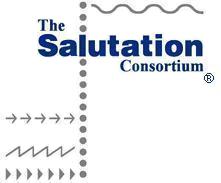
Salutation Press Releases
Media Contacts for the Salutation Consortium
TOOL SUITE FOR SALUTATION ARCHITECTURE HASTENS PRODUCT DEVELOPMENT
Test Tools from Granite Systems Further Enable Implementation of Service Discovery Among Disparate Peripheral Devices
HIGHLAND, Utah, February 22, 2000---The Salutation Consortium, a
non-profit corporation focused on providing service discovery technologies, is
now offering a suite of test tools for developers. The tool suite was developed
by Granite Systems (Boulder, CO, www.granitesystems.com),
a Salutation Consortium member, and is free of charge to all Consortium members.
The test tools perform and verify the correctness of protocol exchanges between client and supported server functional units (FU) for developers using the Salutation architecture. The test suite consists of three elements: the Salutation Manager test driver, the client test driver and device emulation modules. The tools run on Windows 95,Windows 98, and Windows NT platforms.
The
Salutation Manager test driver aids in developing and
testing of a product's base functionality for Salutation personality that
includes individual message by message exchanges. It supports testing of SLM and
FU discovery, attribute retrieval, session management, and message exchange of
Salutation mode products. Message exchange for specific emulated or native
personalities requires custom extensions to the test tool.
The
client test driver helps in developing and testing embedded products such as
print, docStorage, faxSend, and faxData. It automatically performs entire
protocol exchange sequences. For example, it submits a print job and monitors
its progress until completion. The client test driver can accept manual, typed
input, or may execute batch mode scripts. A message trace of protocol exchange
is output from the programs.
The
device emulators aid in developing and testing application program modules. They
support sets of actions that an actual server device might perform.
For example, a print FU can have its paper trays configured, process jobs
on the queue, and set device status such as out of paper.
Device emulators have a graphical user interface that allows users to
simulate a variety of device functions including normal operations, dynamic
events and errors.
The test suite has been verified against several fielded Salutation
products, including IBM's Nu-Office and the Salutation Consortium's Port Of
Entry product.
The
Salutation architecture offers a Find and Bind service discovery solution. It
helps users to locate and detect Salutation-enabled devices, exchange functional
capabilities and locate required services.
The
Salutation architecture is independent of operating system and communication
protocol. This provides for a
single-service discovery implementation across devices, applications and
services.
The
Salutation Consortium is a non-profit corporation that promotes and distributes,
royalty-free, the Salutation Architecture, a service discovery and session
management protocol developed by leading information technology companies.
It is an open standard independent of operating system, communications
protocol or hardware platform.
Member companies include Axis Communications, Canon, Fuji Xerox, Ltd.,
Fujitsu Limited, Granite Systems, Hewlett Packard, Hitachi, IBM, IrDA, Konica,
Kyocera Mita Corporation, Matsushita Electric Industrial Co., MicroBurst, Inc.,
Mitsubishi Electric Corp., Murata Machinery, Ltd., Oki Data Corp., Ricoh
Company, Seiko Epson Corp., Sharp Corporation, TRG Products, Inc., Toshiba TEC,
WalletWare, Inc., and Xerox Corp. Academic members include, Tamal Bose,
University of Colorado; Kaspar Helldén,
Salutation Press Releases
Media Contacts for the
Salutation Consortium
 Order
the Salutation Testing Tools
Order
the Salutation Testing Tools
 Download
Salutation Testing Tools Documentation (1.1MB PDF)
Download
Salutation Testing Tools Documentation (1.1MB PDF)
 Back
Home
Back
Home